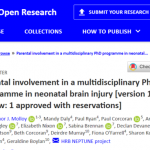Publications
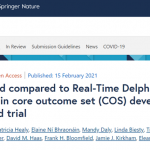
Multi-Round compared to Real-Time Delphi for consensus in core outcome set (COS) development: a randomised trial;Fiona A. Quirke, Patricia Healy, Elaine Ní Bhraonáin, Mandy Daly, Linda Biesty, Tim Hurley, Karen Walker, Shireen Meher, David M. Haas, Frank H. Bloomfield, Jamie J. Kirkham, Eleanor J. Molloy & Declan Devane
NEPTuNE scholar, Fiona Quirke, has had her second paper published in the Trials Journal. The paper refers to a protocol for a randomised trial comparing multi-round and real-time Delphi survey methods to achieve consensus in Core Outcome Set Development.
Click here or more information on the COHESION project or for further info on the NEPTuNE programme.
COHESION: core outcomes in neonatal encephalopathy (protocol); Fiona A. Quirke, Patricia Healy, Elaine Ní Bhraonáin, Mandy Daly, Linda Biesty, Tim Hurley, Karen Walker, Shireen Meher, David M. Haas, Frank H. Bloomfield, Jamie J. Kirkham, Eleanor J. Molloy & Declan Devane
This paper presents the protocol for the COHESION project, outlining how the COHESION team will develop a core outcome set (COS) for neonatal encephalopathy.
The COS will define the most important outcomes that should be measured and recorded in trials to determine the effect of treatments for neonatal encephalopathy. These important outcomes will be contributed by parents, healthcare providers and researchers with experience/expertise of neonatal encephalopathy.
Click here to read more about the COHESION project which is one of the five PhD research projects in the NEPTuNE programme.
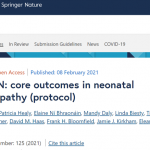
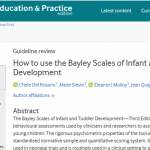
The Bayley Scales of Infant and Toddler Development is a gold standard series of behavioural assessments used by clinicians and researchers to assess the developmental functioning of young children. This paper aims to discuss how to pick an appropriate developmental assessment and outlines indications for the use of the Bayley-III in comparison with other commonly used tools for the assessment of development in children. It discusses the value of the Bayley-III and some of its limitations.
Click here to read more about the PANDA project which is one of the five PhD research projects in the NEPTuNE programme.
A machine-learning algorithm for neonatal seizure recognition: a multicentre, randomised, controlled trial, Andreea M Pavel, Janet M Rennie, Linda S de Vries, Mats Blennow, Adrienne Foran, Divyen K Shah, Ronit M Pressler, Olga Kapellou, Eugene M Dempsey, Sean R Mathieson, Elena Pavlidis, Alexander C van Huffelen, Vicki Livingstone, Mona C Toet, Lauren C Weeke, Mikael Finder, Subhabrata Mitra, Deirdre M Murray, William P Marnane, Geraldine B Boylan
Despite the availability of continuous conventional electroencephalography (cEEG), accurate diagnosis of neonatal seizures is challenging in clinical practice. Algorithms for decision support in the recognition of neonatal seizures could improve detection. We aimed to assess the diagnostic accuracy of an automated seizure detection algorithm called Algorithm for Neonatal Seizure Recognition (ANSeR).
Click to read commentary on this paper and further information about Andreea’s SERENdiPITY project can also be found on our site. The project is part of the NEPTuNE programme.
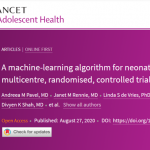
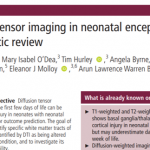
Diffusion tensor imaging (DTI) during the first few days of life can be used to assess brain injury in neonates with neonatal encephalopathy for outcome prediction. The goal of this review was to identify specific white matter tracts of interest that can be quantified by DTI as being altered in neonates with this condition, and to investigate its potential prognostic ability.
Click here to read more about the NEON project which is one of the five PhD research projects in the NEPTuNE programme.
Other NEPTuNE Publications
- Hurley T, et al. Cochrane Review: Bisphosphonates use in children with cerebral palsy (https://doi.org/10.1002/14651858.CD012756.pub2)
- Quirke, F.A., et al. (2022) ‘Core outcomes in neonatal encephalopathy: a qualitative study with parents’. BMJ Paediatrics Open. e001550. (https://pubmed.ncbi.nlm.nih.gov/36053648/)
- Zakharchenko L, El-Khuffash A, Hurley T, Kelly L, Melo A, Padden M, Franklin O, Molloy EJ. Infants with Down syndrome and congenital heart disease have altered peri-operative immune responses. Pediatr Res. 2022 Mar 29. doi: 10.1038/s41390-022-02000-3. Epub ahead of print. PMID: 35352006.
- Abend N w et al. Proceedings of the 13th International Newborn Brain Conference: Neonatal Neurocritical Care, Seizures, and Continuous EEG monitoring. J Neonatal Perinatal Med. 2022;15(2):467-485. doi: 10.3233/NPM-229006. PMID: 35431189.
-
Andreea M. Pavel, MD, et al. Neonatal Seizure Management: Is the Timing of Treatment Critical? (https://pubmed.ncbi.nlm.nih.gov/34626667/et al.)
- Hayes R et al., Molloy EJ; Infection, Inflammation, Immunology and Immunisation (I4) section of the European Society for Paediatric Research (ESPR). Neonatal sepsis definitions from randomised clinical trials. Pediatr Res. 2021 Nov 6. doi: 10.1038/s41390-021-01749-3. Epub ahead of print. PMID: 34743180.
- Isweisi E et all.,Molloy EJ; Newborn Brain Society Guidelines and Publications Committee. Haematological issues in neonates with neonatal encephalopathy treated with hypothermia. Semin Fetal Neonatal Med. 2021 Aug;26(4):101270. doi: 10.1016/j.siny.2021.101270. Epub 2021 Jul 22. PMID: 34330681.
- Wong SK et al. Carbon dioxide levels in neonates: what are safe parameters? Pediatr Res. 2022 Apr;91(5):1049-1056. doi: 10.1038/s41390-021-01473-y. Epub 2021 Jul 6. PMID: 34230621; PMCID: PMC9122818.
- McKenna E et al.,. Neutrophils in COVID-19: Not Innocent Bystanders. Front Immunol. 2022 Jun 1;13:864387. doi: 10.3389/fimmu.2022.864387. PMID: 35720378; PMCID: PMC9199383
- Molloy E, et al. Neuroprotective therapies in the NICU in term infants: present and future (https://pubmed.ncbi.nlm.nih.gov/36195634/)
- Aslam S, et al. Melatonin alters Innate Immune function in infants with Neonatal Encephalopathy. Neonatology 2022
- Ní Bhroin M, Kelly L, Sweetman D, Aslam S, O’Dea MI, Hurley T, Slevin M, Murphy J, Byrne AT, Colleran G, Molloy EJ, Bokde ALW. Relationship Between MRI Scoring Systems and Neurodevelopmental Outcome at Two Years in Infants With Neonatal Encephalopathy. Pediatr Neurol. 2022 Jan;126:35-42. doi: 10.1016/j.pediatrneurol.2021.10.005. Epub 2021 Oct 13. PMID: 34736061.
- Dibble M, et al. Diffusion Tensor Imaging in Very Preterm, Moderate-Late Preterm and Term-Born Neonates: A Systematic Review (https://pubmed.ncbi.nlm.nih.gov/33453200/)
- Pavel AM, et al. A multicenter clinical investigation of a machine learning algorithm for neonatal seizure recognition – a randomized controlled trial, (https://pubmed.ncbi.nlm.nih.gov/32861271/)
- Garvey AA, et al. Multichannel EEG abnormalities during the first 6 hours in infants with mild hypoxic-ischaemic encephalopathy (https://pubmed.ncbi.nlm.nih.gov/33879847/)
- McCarthy KA, et al. Feasibility of non-invasive cardiac output monitoring at birth using electrical bioreactance in term infants, (https://pubmed.ncbi.nlm.nih.gov/33272934/)
- Nguyen VT, et al. Research response to coronavirus disease 2019 needed better coordination and collaboration: a living mapping of registered trials (https://pubmed.ncbi.nlm.nih.gov/33096223/)
- Hurley T, et al. Melatonin treatment for newborns with hypoxic ischaemic encephalopathy, Cochrane Library (https://www.cochranelibrary.com/cdsr/doi/10.1002/14651858.CD013754/full)
- O’Dea MI, et al. Dysregulated Monocyte and Neutrophil Functional Phenotype in Infants With Neonatal Encephalopathy Requiring Therapeutic Hypothermia (https://pubmed.ncbi.nlm.nih.gov/33659224/)
- Sweetman DU, et al. Troponin T correlates with MRI results in neonatal encephalopathy (https://pubmed.ncbi.nlm.nih.gov/32281692/)
- McKenna E, et al. Neutrophils: Need for Standardized Nomenclature (https://pubmed.ncbi.nlm.nih.gov/33936029/)
- Daly MC, Family reflections: importance of sleep in preterm infants. (https://pubmed.ncbi.nlm.nih.gov/31715620/)
- Molloy EJ, et al. Parent, child and public involvement in child health research: core value not just an optional extra (https://pubmed.ncbi.nlm.nih.gov/30531982/)
- Ní Bhroin, M, et al. Relationship between resting-state fMRI functional connectivity with motor and language outcome after perinatal brain injury – A systematic review (https://pubmed.ncbi.nlm.nih.gov/34058624/)
- Molloy, EJ, et al. Parental involvement in a multidisciplinary PhD programme in neonatal brain injury [version 1;peer review:2 approved with reservations] (https://doi.org/10.12688/hrbopenres.13009.1)
- Pavel A, et al. Electroencephalography in a neonate with isolated sulfite oxidase deficiency – a case report and literature review – published HRB Open Research (https://pubmed.ncbi.nlm.nih.gov/34957373/)
- Stephens C, et al. Early Neonatal EEG in Two Infants with Pallister Killian Syndrome (PKS)” – second author; published HRB Open Research (https://hrbopenresearch.org/articles/5-14/v1)
- Garvey, AA, et al. Does early Cerebral Near-infrared Spectroscopy (NIRS) monitoring predict outcome in Neonates with Hypoxic-Ischaemic Encephalopathy (HIE)? – a systematic review” – second author; published (https://doi.org/10.1159/000518687)
- Giraud A, et al. The impact of perinatal inflammation on the electroencephalogram in preterm infants: a systematic review. – second author (https://pubmed.ncbi.nlm.nih.gov/35365760/
- Giraud A, et al. Conventional electroencephalography for accurate assessment of brain maturation in preterm infants following perinatal inflammation. (https://pubmed.ncbi.nlm.nih.gov/35854083/)
- Branagan A, et al. Management of Acute Kidney Injury in Extremely Low Birth Weight Infants (https://doi.org/10.3389/fped.2022.867715)
Our NEPTuNE scholars have also disseminated their research results at many National and International Confernces. Please click on the link below to see a full list of their presentations.
Severe neurological impairment: a review of the definition. Developmental Medicine & Child Neurology, Allen J, Molloy E, McDonald D.
SNI (Severe Neurological Impairment) is a term used widely in medical literature and this review demonstrates that there is wide variation in how it is applied. With the introduction of Core Outcome Sets and Reporting Guidelines, there is an emphasis on having a uniform definition of a patient cohort. An improved definition will provide better accuracy in assessing prevalence, conducting research, planning medical resources and evaluating outcomes.
Click here to read more about the SERENITY programme.
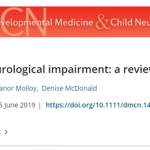
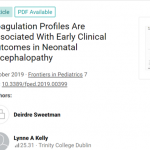
- Coagulation Profiles Are Associated with Early Clinical Outcomes in Neonatal Encephalopathy. Sweetman D, Kelly LA, Zareen Z, Nolan B, Murphy J, Boylan G, Donoghue V, Molloy EJ.
- Management of Multi Organ Dysfunction in Neonatal Encephalopathy. O’Dea M, Sweetman D, Bonifacio SL, El-Dib M, Austin T, Molloy EJ. Front Pediatr. 2020 May 15;8:239
- Troponin T correlates with MRI results in neonatal encephalopathy. Sweetman DU, Kelly L, Hurley T, Onwuneme C, Watson RWG, Murphy JFA, Slevin M, Donoghue V, Molloy EJ.Acta Paediatr. 2020 Nov;109(11):2266-2270.
- Biomarkers of multiorgan injury in neonatal encephalopathy. Aslam S, Molloy EJ.Biomark Med. 2015;9(3):267-75.
- Neonatal Encephalopathy: Need for Recognition of Multiple Etiologies for Optimal Management. Aslam S, Strickland T, Molloy EJ.
- Upregulation of Immune Inflammatory gene expression in Neonatal Encephalopathy. M O’Dea, L Kelly, O’Leary JJ, Sweetman D, EJ Molloy. Pediatric Research published abstract 2017.
- Multi-Organ Dysfunction Scoring In Neonatal Encephalopathy: MODE score. Sweetman D, Donoghue V, Boylan GB, Segurado R, Murphy JF, Molloy EJ. Pediatric Research published abstract 2017.
- Serial cytokine alterations and abnormal neuroimaging in newborn infants with encephalopathy. O’Hare FM, Watson RW, O’Neill A, Segurado R, Sweetman D, Downey P, Mooney E, Murphy J, Donoghue V, Molloy EJ. Acta Paediatr. 2017 Apr;106(4):561-567.
- Perinatal Asphyxia and Erythropoietin and VEGF: Serial Serum and Cerebrospinal Fluid Responses. Sweetman DU, Onwuneme C, Watson WR, Murphy JF, Molloy EJ. Neonatology. 2017;111(3):253-259.
- Renal function and novel urinary biomarkers in infants with neonatal encephalopathy. Sweetman DU, Onwuneme C, Watson WR, O’Neill A, Murphy JF, Molloy EJ. Acta Paediatr. 2016 Nov;105(11):e513-e519.
Click here to read more about the NIMBUS project.
Parental involvement in a multidisciplinary PhD programme in neonatal brain injury: Eleanor J. Molloy, Mandy Daly, Paul Ryan, Sabina BrennanElaine Ni Bhraonain, Geraldine Boylan,
Parental and patient and public involvement (PPI) involvement is a core element of the Neonatal Brain Consortium Ireland Ireland (NBCI) since its inception. PPI representatives were critical to the development of the Consortium and the animations for parent information as well as the NEPTUNE Neonatal Encephalopathy PhD programme in which they are core members involved in PhD supervision, publications, study days and educational outreach. Key outputs have also included national clinical guidelines and parent information.
Click here to read more about the NEPTuNE programme.
